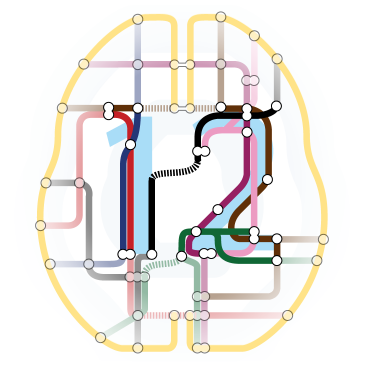Important
This guide hasn’t been updated since January 2017 and is based on an older version of Nipype. The code in this guide is not tested against newer Nipype versions and might not work anymore. For a newer, more up to date and better introduction to Nipype, please check out the the Nipype Tutorial.
All you need to know to download and install Nipype can be found on the official homepage under Download and Install. There you find a link to the newest version and more information about which dependencies are necessary or recommended.
Installing Nipype as described on the official homepage should be rather easy for most users. There are some tricky steps that sometimes seem to be less straight forward. But don’t worry, I’ve written my own installation guide to help and assist users with less UNIX experience. The following instructions hopefully help everybody to install and run Nipype on their system. Note that some steps strongly depend on the system you are using and it might be possible that some dependencies are already installed on your system. Also,
Note
It is highly recommended to run Nipype on a machine with either a Mac or Linux OS, as most dependencies such as FSL or FreeSurfer don’t run on Windows. If you have a Windows machine, I recommend you to install Ubuntu on your system.
The following steps describe how I was able to set up and run Nipype on a System with a newly installed Ubuntu 14.04 LTS OS (64-bit), called “trusty”. To people with older Ubuntu version, don’t worry, Nipype does also run on much older versions, as long as they are not too ancient. To check which version of Ubuntu you are running use the command lsb_release -d. You don’t have to upgrade to version 14.04 if you have an older version as long as it isn’t too ancient.
To Mac Users: I haven’t installed Nipype on a Mac, yet. But the steps should be almost identical. If any major differences occur, please let me know.
Before we start, make sure that your Ubuntu system is up to date with the following command:
#Update and upgrade your system
sudo apt-get update && sudo apt-get upgrade

As you can see under Dependencies, there are a lot of software packages that have to be installed on your system to run Nipype. For example: python, ipython, matplotlib, networkx, numpy, scipy, sphinx etc. Luckily, most of the those required dependencies, most importantly a working Python environment, can be set up by installing Anaconda.
Instructions on how to install Anaconda can be found on the official homepage. Following are the steps how I’ve installed the Anaconda package on my system:
Download the software under https://www.continuum.io/downloads and move the downloaded sh-file to your Download folder. In my case this folder is at /home/username/Downloads abbreviated with ~/Downloads.
Install the downloaded sh-file with the following command:
bash ~/Downloads/Anaconda-2.1.0-Linux-x86_64.sh
Specify the location of the installation (default is ok).
Add the anaconda binary directory to your PATH environment variable. This path is automatically added if you answer the question “Do you wish the installer to prepend the Anaconda install location to PATH in your /home/username/.bashrc ? [yes|no]” with yes. Otherwise, add the following line to your .bashrc file:
export PATH=/home/username/anaconda/bin:$PATH
Note
.bashrc is read and executed whenever you run bash using an interactive shell, i.e. the terminal. This file usually is stored in your home folder at /home/username/.bashrc or in other words ~/.bashrc. The export command tells your system to export a variables from the specified package so that they can be used inside the current shell. For example, export PATH=/home/somepath:$PATH inserts /home/somepath to the beginning of the variable PATH and exports it.
To update anaconda to the newest version and to clean unused and older content use the following command:
conda update conda && conda update anaconda && conda clean --packages --tarballs
Now make sure that you have all Nipype required dependencies up to date with the following command:
conda update python ipython ipython-notebook matplotlib \
networkx numpy scipy sphinx traits dateutil nose pydot
Note
To update a software package in anaconda use the command “conda update packagename”. For example, if you want to update python use “conda update python”
Now that Anaconda is installed let’s test if our python environment is ready to run.
Open a new terminal and type in the command ipython. This should bring you to the IPython environment. IPython is used to run all your python scripts. Fore more information about Python and IPython see the support section of this beginner’s guide.
To check if everything is set up correctly try to import numpy with the following command:
import numpy
If you see no ImportError message, everything is fine and we can get on to the next step.

To facilitate the installation of some necessary and recommended software packages such as FSL and Nipype itself, Debian and Ubuntu based system should install the NeuroDebian repository. To see which software packages are included in NeuroDebian, go to NITRCT - NeuroDebian.
To install NeuroDebian on your System go to the Get NeuroDebian and select the operating system and the server you want to use. In my case, the operating system is ‘Ubuntu 14.04 “Trusty Tahr” (trusty)’. If you have an Ubuntu OS but don’t know which version, just type lsb_release -a in the terminal and it will show you.
Chose the option “All software”
Now you should see two lines of command. In my case they were the following:
wget -O- http://neuro.debian.net/lists/trusty.de-md.full | sudo tee /etc/apt/sources.list.d/neurodebian.sources.list sudo apt-key adv --recv-keys --keyserver pgp.mit.edu 2649A5A9
Run those two lines of code in your terminal.
After all this is done, update your system with the following command: sudo apt-get update
Now you are read to install Nipype, FSL, AFNI and more.
Note
If you have problem with the wget command in the 3rd step it is most likely because of the root permission (the sudo command in the second half of the command). When the wget command seems to halt and do nothing type in your password and it should go on.

Finally, it’s time to install Nipype. There are multiple ways how you can install Nipype, but assuming that you installed anaconda beforehand, the easiest way to install Nipype is by using conda. To do this you need to add the channel conda-forge to your channels:
conda config --add channels conda-forge
Once the conda-forge channel has been enabled, nipype can be installed with:
conda install nipype
As an alternative, you could also install Nipype with either pip install -e git+https://github.com/nipy/nipype#egg=nipype or easy_install nipype. For more information about the installation from sourcecode, go to the main page.
There are a few additional python dependencies that you cannot install via anaconda, such as: nibabel, rdflib, nipy, dipy and graphviz. To install those, use the following command:
#Install packages with pip
pip install nibabel rdflib nipy dipy
#Install graphviz and pygraphviz separately
sudo apt-get install graphviz libgraphviz-dev
pip install --upgrade pygraphviz graphviz
To test if everything worked fine and if you’re able to use Nipype go into an IPython environment and import nipype with the command: import nipype. If you see no ImportError message, everything is set up correctly.
If you want to be sure that you have the newest version or update a certain package use the pip install command with the flag --upgrade. So, if you want to upgrade Nipype to the newest version use the following command:
pip install --upgrade nipype
If you want to upgrade all other required python dependencies as well use the following command:
pip install --upgrade nibabel nipype rdflib nipy dipy pygraphviz graphviz
If you want or have to upgrade Nipype to the developer version us the following steps. Such an upgrade is only recommended to people who know what they are doing or need a certain fix that isn’t distributed yet in the general Nipype version.
The most current developer version of Nipype can be found on GitHub under Nipype @ GitHub. The following steps assume assume that you’ve already set up your own GitHub account and are ready to download the Nipype repository:
First, open a terminal and download the Nipype repository at the current location with git clone https://github.com/nipy/nipype.git, or download the repository directly by using this link.
The just downloaded nipype folder contains another folder called nipype. This is the folder that contains the newest version of Nipype.
Now, either add the path to this folder to the PYTHONPATH list (make sure that PYTHONPATH only contains one Nipype folder) or delete the current nipype folder and move the new github nipype folder to this location. This can be done with the following command:
rm -rf ~/anaconda/lib/python2.7/site-packages/nipype cp -R ~/Downloads/nipype/nipype ~/anaconda/lib/python2.7/site-packages/nipype
Note
If you haven’t set up a GitHub account yet but don’t know how to set everything up, see this link: Set Up Git.

FSL is a comprehensive library of analysis tools for fMRI, MRI and DTI data. An overview of FSL’s tools can be found on their homepage under FSL Overview.
The installation of FSL is simple if you’ve already installed the NeuroDebian repository.
Just run the following command:
sudo apt-get install fsl
Otherwise, go through the official FSL installation guide.
Before you can run FSL, your system first needs to know where the software is installed at. On a ubuntu system, this is usually under /usr/share/fsl. Therefore, add the following code to your .bashrc file. (To open and edit your .bashrc file on Ubuntu, us the following command: gedit ~/.bashrc)
#FSL
FSLDIR=/usr/share/fsl
. ${FSLDIR}/5.0/etc/fslconf/fsl.sh
PATH=${FSLDIR}/5.0/bin:${PATH}
export FSLDIR PATH
To test if FSL is correctly installed, open a new terminal and type in the command fsl. If everything was set up correctly you should see the FSL GUI with the version number in the header. In my case this is version 5.0.7.

FreeSurfer is an open source software suite for processing and analyzing (human) brain MRI images. The installation of FreeSurfer includes abit more steps than the other installations, but the official FreeSurfer: Download and Install homepage is written very well and should get you through it without any problem. Nonetheless, following are the steps how I’ve installed FreeSurfer on my system.
Go to FreeSurfer: Download and download the corresponding version for your system. In my case this was the Linux CentOS 6 x86_64 (64b) stable v5.3.0 version. The file is called freesurfer-Linux-centos6_x86_64-stable-pub-v5.3.0.tar.gz.
Unpack FreeSurfer’s binary folder to the place where you want the software to be at. In my case, I want to install FreeSurfer at /usr/local/freesurfer, which in my case needs root privilege. In my case this all can be done with the following command:
sudo tar xzvf \ ~/Downloads/freesurfer-Linux-centos6_x86_64-stable-pub-v5.3.0.tar.gz -C /usr/local/
The usage of FreeSurfer requires a license file. Therefore, before you can use FreeSurfer, make sure to register. The content of the license file looks something like this:
username@gmail.com 12345 *A3zKO68mtFu5This key has to be saved under a file with the name .license and has to be stored at your
$FREESURFER_HOMElocation. In my case, this is/usr/local/freesurfer. To create this file in an Ubuntu environment use the following command:sudo gedit /usr/local/freesurfer/.licenseNow copy the license code into this file, and save and close it.
The last thing you have to do before you can use FreeSurfer is to tell your system where the software package is. To do this, add the following code to your .bashrc file:
#FreeSurfer export FREESURFER_HOME=/usr/local/freesurfer source $FREESURFER_HOME/SetUpFreeSurfer.sh
After setting everything up, we can test if FreeSurfer is set up correctly and run a test with the following command:
#Test 1
freeview -v $SUBJECTS_DIR/bert/mri/brainmask.mgz \
-v $SUBJECTS_DIR/bert/mri/aseg.mgz:colormap=lut:opacity=0.2 \
-f $SUBJECTS_DIR/bert/surf/lh.white:edgecolor=yellow \
-f $SUBJECTS_DIR/bert/surf/rh.white:edgecolor=yellow \
-f $SUBJECTS_DIR/bert/surf/lh.pial:annot=aparc:edgecolor=red \
-f $SUBJECTS_DIR/bert/surf/rh.pial:annot=aparc:edgecolor=red
#Test 2
tksurfer bert lh pial -curv -annot aparc.a2009s.annot
Note
On a new Ubuntu System this might lead to the following error: freeview.bin: error while loading shared libraries: libjpeg.so.62: cannot open shared object file: No such file or directory. This is a common error on Ubuntu and can be solved with the following command:
cd /usr/lib/x86_64-linux-gnu
sudo ln -s libjpeg.so.8 libjpeg.so.62
sudo ln -s libtiff.so.4 libtiff.so.3
Alternately, this error can sometimes also be overcome by installing the libjpeg62-dev package with the following command: sudo apt-get install libjpeg62-dev

Nowadays almost all scientific fields take advantage of MATLAB. Neuroscience is no exception in this and also some of Nipype’s recommended interfaces can (but don’t have to) take advantage of MATLAB, e.g. SPM, FSL, FreeSurfer.
Having MATLAB is always a good thing, and as I myself rely often on algorithms from the SPM interface, I need it to be on my system. A detailed documentation on how to install MATLAB can be found here. In my case, MATLAB is installed at the following location: /usr/local/MATLAB/R2014a.
The only thing you need to do to run MATLAB on your Ubuntu System is to add the following lines to your .bashrc file:
#MATLAB
export PATH=/usr/local/MATLAB/R2014a/bin:$PATH
export MATLABCMD=/usr/local/MATLAB/R2014a/bin/glnxa64/MATLAB
To test if everything is set up correctly. Open a new Terminal and type in the command: “matlab”.

SPM stands for Statistical Parametric Mapping and is probably one of the most widely-used neuroimaging analysis software package worldwide. SPM is based on MATLAB and therefore needs it to be installed on your system. Luckily, the previous step just made that sure.
As of 1st October 2014, SPM released it’s newest version SPM12. The Release Notes mention some important updates and I therefore recommend to use SPM12 instead of SPM8. Nonetheless, Nipype has no issue with either SPM8 or SPM12. Therefore, you can install the version that you prefer.
Note
There is a standalone version of SPM available that doesn’t need MATLAB, but so far it isn’t recommended as a lot of additional toolboxes don’t work with the standalone, yet. For more information go on the SPM wikipage.
To download and install the newest version SPM12 do as follows:
Got to SPM12’s Download and registration page and fill out the form. Under Select SPM version required, chose SPM12 (or SPM8 if preferred) and download the zip file.
Now, unpack the zip file and copy the content to the recommended folder /usr/local/MATLAB/R2014a/toolbox/ use the following code:
sudo unzip ~/Downloads/spm12.zip -d /usr/local/MATLAB/R2014a/toolbox/Note: You don’t have to put the spm12 folder into this folder, just make sure that you tell your system where to find it.
Now tell your system where it can find SPM12 by adding the following line to your .bashrc file:
#SPM12 export SPM_PATH=/usr/local/MATLAB/R2014a/toolbox/spm12/
Now, set up your MATLAB startup.m script so that MATLAB knows where SPM12 is stored at. If you’ve already installed FreeSurfer, than the startup.m file should be at ~/matlab/startup.m. Otherwise create it and save it at this location. Now add the following code to this file:
%-SPM12- spm_path = getenv('SPM_PATH'); if spm_path, addpath(spm_path); end
Note
There are some interesting ways on how you can change the default behaviors of your SPM.
Example 1: By default, SPM uses only 64MB of memory during GLM estimation. This can be changed by changing the defaults.stats.maxmem parameter. Change this value to 2^29 and use 512MB or to 2^30 and use 1GB of memory during GLM estimation. Another option only available in SPM12 is to set defaults.stats.resmem = true;. Setting this parameter to true means that the temporary files during GLM estimation are kept in memory and not stored on disk (if value is set to false). For more information about increasing the speed of your SPM see the official Faster SPM section.
Example 2: One computational unimportant but nice parameter to change is defaults.ui.colour = [0.141 0 0.848];. Change it to the recommended value and see the nice color change in your SPM GUI.
How to change those values: SPM8 and SPM12 differ a bit in how those changes have to be implemented. In SPM8 you can change the default behavior by directly changing the parameters in the spm_defaults.m file, stored in the spm8 folder. If you want to change default values in SPM12, you should create a new file called spm_my_defaults.m, store it in your spm12 folder. The first line of your spm_my_defaults.m file has to be global defaults, followed by all the parameters you want to change, e.g. defaults.ui.colour = [0.141 0 0.848];
To test if SPM12 is set up correctly, open MATLAB and type in the command spm fmri. This can also be achieved in one command: matlab -r "spm fmri".

ANTs stands for Advanced Normalization Tools and is a great software package for registration, segmentation and normalization of MRI data. I highly recommend to use ANTs for the normalization of your data. Side note: ANTs can also be used to create a very cool looking average brain (template) out of a your own population of subjects.
There are two ways how you can set up ANTS on your own system:
The first way is very fast and simple. Just download the newest release of ANTs from their official github homepage. Decompress the downloaded files and store them somewhere on your system, e.g. under /usr/local/antsbin. After you’ve done that, just add the following line to your .bashrc file so that your system knows where to find the ANTs binaries:
#ANTs export PATH=/usr/local/antsbin/bin:$PATH export ANTSPATH=/usr/local/antsbin/bin/
The second way to get ANTs on your system takes a bit longer, but guarantees that you have the newest version of ANTs, specifically compiled for your system. Do as follows:
Download the data from the official homepage http://stnava.github.io/ANTs/. I chose the “Download TAR Ball” option.
Unpack the just downloaded files to a subfolder in your download folder (or wherever you want) with the following command:
tar xzvf ~/Downloads/stnava-ANTs-b4eb279.tar.gz -C ~/Downloads
The installation of ANTs differs from other installation by the fact that the software first has to be compiled before it can run on your system. The code has to be compiled to create the binary files specific for your system. To do this, we first need to create a temporary folder to store all important files. This can bed one with the following code:
mkdir ~/Downloads/stnava-ANTs-b4eb279/antsbin
Go into this folder with cd ~/Downloads/stnava-ANTs-b4eb279/antsbin and proceed with the following steps:
#1. Install ccmake and other dependencies to be able to compile the code sudo apt-get install cmake-curses-gui build-essential zlib1g-dev #2. ccmake ../../stnava-ANTs-b4eb279 #3. Press the [c] button to configure the compilation options #4. Change the CMAKE_INSTALL_PREFIX value to /usr/local/antsbin #5. First press the [c] and than the [g] button to generate the code #6. Now everything is set up to compile the code make -j 4 #7. Now you're ready to install ANTs with the following commands: cd ANTS-build/ sudo make install #8. Use the following command to copy important scripts from # the ANTs folder 'stnava-ANTs-b4eb279/Scripts' into the folder # where you've stored the ANTs binaries sudo cp ~/Downloads/stnava-ANTs-b4eb279/Scripts/* /usr/local/antsbin/bin/ #9. Now that everything is done you can delete the temporary folder # 'stnava-ANTs-b4eb279' again.
Just one last thing before your can run ANTs, add the following lines to your .bashrc file:
#ANTs export PATH=/usr/local/antsbin/bin:$PATH export ANTSPATH=/usr/local/antsbin/bin/

AFNI is an open source software package specialized on the analysis of functional MRI. To see a list of all AFNI algorithms that can be used with Nipype go to interfaces.afni.preprocess.
If you’ve installed the NeuroDebian repository, just use the following command to install AFNI on your system: sudo apt-get install afni
To be able to run AFNI make sure to add the following lines of code to your .bashrc file:
#AFNI
export PATH=/usr/lib/afni/bin:$PATH
There are many additional interfaces, such as Camino, MRtrix, Slicer, ConnectomeViewer, for which I haven’t created an installation guide yet. This is also due to my lack of knowledge about them. Feel free to help me to complete this list.
Now that everything is downloaded and installed, make sure that everything is correctly updated with the following command:
#Update and upgrade your system
sudo apt-get update && sudo apt-get upgrade
#Optional 1: Upgrade your distribution with
sudo apt-get dist-upgrade
#Optional 2: Clean your system and remove unused packages
sudo apt-get autoremove && sudo apt-get autoclean
sudo apt-get remove && sudo apt-get clean
Nipype is installed, recommended interfaces are ready to go and so are you. But before you want to start your first steps with Nipype, I recommend you to test your system first. To do this open up an IPython environment (open a terminal and start IPython with the command ipython) and run the following code:
# Import the nipype module
import nipype
# Optional: Use the following lines to increase verbosity of output
nipype.config.set('logging', 'workflow_level', 'CRITICAL')
nipype.config.set('logging', 'interface_level', 'CRITICAL')
nipype.logging.update_logging(nipype.config)
# Run the test: Increase verbosity parameter for more info
nipype.test(doctests=False)
This test can take some minutes but if all goes well you will get an output more or less like this:
Ran 7454 tests in 71.160s
OK (SKIP=10)
Out[7]: <nose.result.TextTestResult run=7454 errors=0 failures=0>
Don’t worry if some modules are being skipped or some side modules show up as errors or failures during the run. As long as no main modules cause any problems, you’re fine. The number of tests and time will vary depending on which interfaces you have installed on your system. But if you receive an OK, errors=0 and failures=0 then everything is ready.
Congratulation! You now have a system with a fully working Nipype environment. Have fun!
Note
The first time I used MATLAB in Nipype I got the following error message:
Standard error:
MATLAB code threw an exception:
SPM not in matlab path
File:/home/username/workingdir/sliceTiming/pyscript_slicetiming.m
Name:pyscript_slicetiming
Line:6
Return code: 0
Interface MatlabCommand failed to run.
Interface SliceTiming failed to run.
As mentioned in the error message SPM not in matlab path, Nipype can’t find the path to SPM. To change that, you can either add addpath /usr/local/MATLAB/R2014a/toolbox/spm12b to your startup.m file, stored at ~/matlab/startup.m or add the following line of code at the beginning of your Nipype script:
from nipype.interfaces.matlab import MatlabCommand MatlabCommand.set_default_paths('/usr/local/MATLAB/R2014a/toolbox/spm12b')